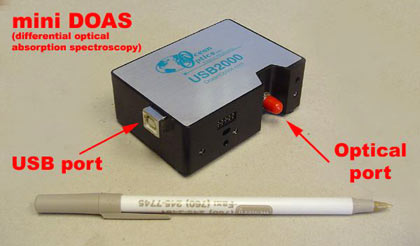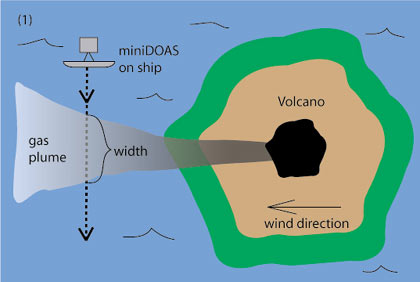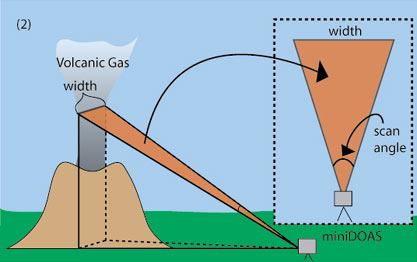

| the expedition | |
| the science | |
| marianas history | |
| daily journal | |
| the team | |
| questions & answers | |
|
the islands Saipan Anatahan Sarigan Guguan Alamagan Pagan Agrigan Asuncion Maug Uracas |
|
|||||||||||||||||||||||||||||||||||||||||||||||||||||||||||||||
Mini DOAS


Water, carbon dioxide, sulfur dioxide and other volatiles within sediments and the base of the downgoing plate enter the mantle at subduction zones. Some of these volatiles are recycled back to Earth's surface through volcanic emissions. To estimate the efficiency of recycling we need to quantify the output of gases via volcanism. In other words, we want to know what fraction of the volatiles taken into the mantle at the trench makes it back to the surface.
To make this estimate, we need to calculate a flux-the amount of gas exiting the volcano per day. We concentrate on sulfur dioxide (SO2) gas emissions for two reasons: volcanic gases contain a lot of sulfur dioxide, much higher than the concentration of SO2 in the atmosphere, and sulfur dioxide scatters visible light (blocks sunlight) at a specific wavelength (~600-900 micrometers) that is different from other molecules abundant in the atmosphere.
On this expedition, we will be using a mini-DOAS (differential optical absorption spectrometer). It is ideal for our expedition to the Mariana Islands because it is small and lightweight (less than one pound), so we can carry it with us in our backpacks on long hikes. We can also use it from the helicopter. We use a telescope and fiber optics cable to focus the incoming light on the spectrometer. A laptop computer that is also used to collect data supplies the power.


Prior to this field trip, we tested the mini-DOAS at two locations. First, we went to Masaya volcano in Nicaragua and then to a power plant in New Mexico (see video). We tested different methods to collect spectral data. In the first case, we moved relative to the plume of gas emitted by the volcano (Figure 1 is an example). As shown on the video, we drove under the plume with the telescope sticking out of the car window. In the second case, we were stationary and scanned the plume over a variety of angles using a tripod (Figure 2).

The mini-DOAS works by measuring the intensity of light radiating from the sun. When particulates such as the water in clouds or sulfur dioxide interfere with sunlight, the mini-DOAS detects less light, much like shadows created when there are partially cloudy skies. The amount of light reduced depends on the concentration of the particulates in the atmosphere. Thus, lower intensity equals more SO2. We measure the difference in light by taking measurements outside of the gas plume, then scanning into the plume to measure the drop in light level. This difference gives us a concentration that we later use to calculate a flux.
